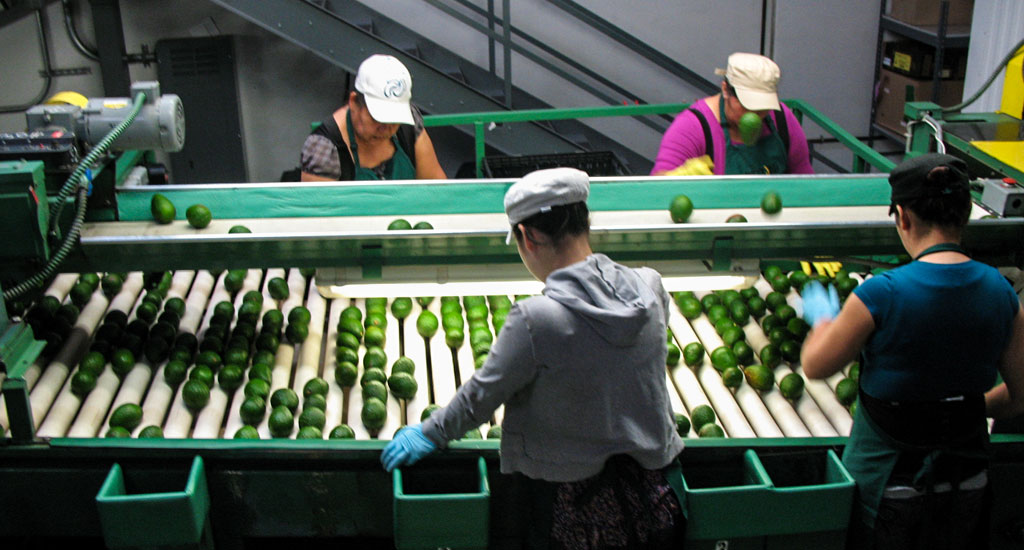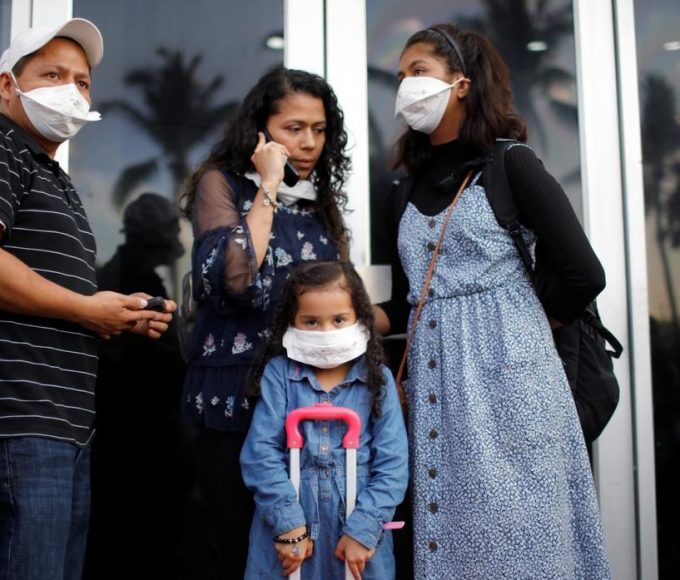Our appetite for avocados has made them more valuable than cannabis in Mexico—and drug syndicates have taken notice, forming veritable avocado cartels.
Here’s a riddle for you: What do hipsters, Super Bowl watchers, the Chipotle food chain, California’s chronic water shortages, and drug cartels have in common? They’ve all played a notable role in the incredible growth and profitability of Mexico’s multibillion-dollar avocado industry.
Farmers’ “green gold” just keeps getting greener, and the reasons why offer some incisive lessons on the laws of supply and demand.
There is, of course, little question about the demand. Regardless of whether avocados get smashed into guacamole, spread on $9 avocado toast, wrapped into burritos and tacos, eaten straight from the fruit’s skin as part of a health craze, distilled into cooking oil, or mashed on Miley Cyrus’ face, one thing is clear: The United States is in the midst of a 21st century avocado binge that shows no signs of abating.
In 2014, Americans ate 4.25 billion avocados. That’s double the number of a decade earlier and four times more than in 2000.
There’s a lot to say about Americans’ tendency to gorge on the latest magic-bullet health food, but that all seems secondary to the drug cartel-driven mayhem on the supply side of the avocado industry. To fill countless avocado bins for American consumers, too often, the green runs red.
Avocados, Drugs, and Cartels
Mexico produces nine out of every 10 avocados eaten in the U.S. The lion’s share dangle from long lines of leafy green trees in Michoacán, home to nearly 5 million people. In 2017, the strife-torn southwestern coastal state sent an astounding 1.7 billion pounds of Haas avocados to the U.S.
They come from places like Tancítaro, a municipality of about 31,000 people that sits on fertile volcanic earth about 2,000 meters in elevation. Nature has bequeathed the area with ideal conditions—regular rain and fertile soil—to grow avocados on nearly perfect rows of aguacateros, with some reaching the height of forest canopies.
Drive past the shopkeeper signs that say “we buy avocados” and go around the large fruit transport trucks, and you are likely to come across a metallic statue of the outside of an avocado. The circular pit inside is a small model of Earth. Just below, Tancítaro’s name, spelled out for all to see.
The avocado isn’t the center of the world; the world is the center of an avocado. And Tancítaro, as local leaders say, is the “global avocado capital.”
And in the notoriously troubled state of Michoacán, which is plagued with corrupt police, failed governance, and plenty of guns, all those avocados have been a magnet for organized crime like flies on a giant vat of, well, guacamole.
Drug Cartel 2.0
In the decade leading up to 2015, the state of Michoacán endured an average of over 800 murders annually. By contrast, New York City, which has nearly double the population, had 290 homicides.
Perhaps the most famous Mexican crime syndicate is the Zetas, a group of former army commandos. In the 1990s, they became an enforcement arm of the Gulf Cartel before breaking out on their own. The Zetas have profited from the sex trade, protection rackets and other forms of extortion, human trafficking, and most famously, drugs. They engaged in bribery—buying off top officials—but often found brutality to be more productive. The remains of their tortured victims have been a crucial part of the communications efforts of a gang that, for years, had the widest geographic reach in all of Mexico.
In some ways, the Zetas created a model of organized criminality in Michoacán that proved to be the crime groups’ most enduring legacy there.
La Familia (Michoacána) was just one of the rising cartels that seized on the brutal mob template and ate away at the Zetas’ revenue-generating enterprises. In 2006, black-clad, rifle-bearing members of La Familia, a splinter group of the Zetas, burst into a bar in Michoacán and tossed five severed human heads onto a packed dance floor. It was the local coming-out for a rising crime syndicate.
The avocado industry, meanwhile, was surging in value. In the mid-1990s, before the North American Free Trade Agreement facilitated the import of foreign avocados, the typical American ate about a pound of California-grown “butter fruit” each year. In recent years, the average American has gobbled more than seven pounds of mostly imported avocados annually. In 2017, avocado imports to the United States were worth well over $2 billion—and the vast majority came from Michoacán.[/vc_column_text][/vc_column][/vc_row][vc_row][vc_column][vc_empty_space height=”41px”][vc_column_text]Today, avocados dominate the state’s economy. Nearly 60 percent of all of its farming revenue is estimated to come directly or indirectly from green gold, according to the Association of Avocado Producers, Packers and Exporters of Michoacán (APEAM). The trade association says the industry supplies 100,000 direct jobs and indirectly funds another 200,000.
In tiny Tancítaro, APEAM says that 9 out of every 10 pesos comes from the industry, which generates more than $1 million every day there. Such sums of money were never going to go unnoticed by organized crime. As early as 2007, mobsters recognized an emerging opportunity, as Michoacán became the first state in Mexico that the U.S. Department of Agriculture allowed to send unlimited imports of avocados over the northern border.
The export market quickly blossomed. Within three years, Michoacán was sending four out of every five avocados it harvested to the U.S. These days, Mexican avocado exports to the U.S. are worth about $2.2 billion.
Avocados soon became more lucrative to Michoacán than marijuana, which drew the attention of various mafia groups, like La Familia Michoacána, and the cartel’s leader, Nazario Moreno Gonzalez. Narcocorridos immortalized Nazario as a volatile man, as did his many nicknames, including El Más Loco. A guy who might fit into the cinematic world of Quentin Tarantino, the hard-partying young Nazario once got beaten so badly during a fight in an amateur soccer match that surgeons used a metal plate to hold his skull together. Afterward, according to an account in the award-winning book Gangster Warlords by Mexico City-based journalist Ioan Grillo, whenever Nazario got angry and leered at you, the metal plate made it look like his forehead was bulging. Nazario later said he cleaned up, crediting Alcoholics Anonymous for his transformation. In addition to becoming a member of the 12-step recovery program, he became an Evangelical Christian. Reborn, he became a new man with the focus and discipline to live his dream: become a kingpin.
It was a mafia war-meets-holy war—and it worked. In 2009, authorities put a multimillion-dollar bounty on his head. El Mas Loco was Mexico’s Most Wanted.
To inspire his followers—or to recruit others in churches and drug rehabs he donated money to—Nazario spread pseudo-religious tracts, including this one cited in Grillo’s book: “I ask God for strength and he gives me challenges that make me strong; I ask for wisdom and he gives me problems to solve.” But when federal authorities designated Nazario Mexico’s Public Enemy No. 1, it seemed to be a problem too big to solve. Acting on a tip, 2,000 federal troops closed in on a Christmas party in Apatzingán, several hundred miles west of Mexico City. Intel said Nazario was in attendance, along with an estimated 500 well-armed gangsters. In the shootout that ensued between them and los federales, 50 cartel members died including, authorities said, Nazario. He had, it seemed, been sent to whatever Lord he believed in.
Unfortunately, authorities clarified, cartel members escaped with their leader’s corpse and a grave with Nazario’s name on it soon appeared. Shrines quickly began to spring up around the intensely religious Michoacán—Nazario was becoming another of Mexico’s ubiquitous saints. He was present in other ways, as well: locals began reporting visions of the mobster-minister’s ghost. For whatever reason, no one conducted a legitimate DNA test of the corpse, or if they did, they were too afraid to share the results. Nazario himself could have explained that it wasn’t necessary, but he was busy with other things. In “death,” El Más Loco was continuing his work, collaborating with associates to essentially transform La Familia Michoacána into The Knights Templar, according to Grillo’s account.
The group’s name was taken from a movement of crusaders between the 1100s and the 1300s, who aimed to protect European pilgrims on the way to Christian holy lands.
While clearly an inspiration for the newly-formed Knights, Nazario was still dead—at least officially. The formal leader of the Knights was Servando “La Tuta” Gomez, an unassuming former schoolteacher who came to lead a crystal meth empire that has been described as Mexico’s answer to Breaking Bad. La Tuta took inspiration from the iconic Latin American revolutionary Che Guevara while also issuing quasi-religious dictates that added up to something of a tough-love mafia code customized for Mexico. The Knights even created a coat of arms and a list of 53 “commandments” that cartel members were supposed to live by.
That code clearly left room for some strange and horrific behavior. New members were initiated or promoted in fraternity-from-hell ceremonies in which cartel members, dressed up as medieval knights, were required to chop up human corpses, or, in some cases, eat parts of them.
One overriding message from La Tuta and his Knights to their subjects in Michoacán was, essentially, to respect their rules. Do that, and you will be fine. Otherwise, you will endure God’s wrath.
They were carving out their niche among an array of cartels that oversaw expanding—and competing—empires built on marijuana, cocaine, heroin, and meth destined for Mexico’s neighbor to the north.
For all its extreme trappings, the Knights Templar was ultimately about generating revenue, which means it was deft enough to diversify into legitimate and semi-legitimate businesses—in their criminal way.
After forcing landowners to choose between death or torture, and signing their land over to the syndicate, the Knights went into farming, harvesting Michoacán’s limes and avocados. Their place in the ever-growing green gold trade allowed them to earn legal profits, and provided an efficient way to launder money.They also slapped “taxes” on avocado packing and shipping companies—including some owned by Americans. In actions that reinforced their extortion threats, Knights are believed to be behind the torching of a pair of packing centers in Tancítaro.
For their efforts, the Knights Templar and other cartels in Michoacán were, for a time, estimated to control one in every ten avocado orchards in the state. The estimated value: $150 million.
The Avocado Vigilantes
José Manuel Mireles Valverde might as well have stepped out of an old Hollywood western and onto the disheartened public squares of Michoacán. Amid the Knights Templar’s cruel reign, he offered visions of an unimaginably better world to residents who had largely given up hope.
Townspeople in avocado country were transfixed by the lanky man with piercing brown eyes, a white mustache and a cowboy hat. Mireles looks a lot like Sam Elliott in old Western films, but it was his cojones and stories that won people over. Mireles was a doctor until the drug cartels altered his path. When he spoke of the near absolute impunity of the Knights Templar, he was speaking from personal experience. Knights had taken him hostage and ransomed him, he explains in Cartel Land. Some of his relatives were murdered. He showed the filmmakers a photo he carried with him of his dead neighbors whose heads were mounted on a wall opposite his home like terror-inducing trophies.One day, Mireles—who previously spent a decade living in Modesto, California—had enough. He joined together with dozens of others victims of the Knights, each with her or his own horror stories about the crime syndicate, and created a vigilante “self-defense” unit.
Mireles’ group, like others that emerged, began as a voluntary structure whose members armed and trained themselves. Their motivation was to liberate the people from the tyranny of crime syndicates, corrupt cops, and a discredited political class.
He would call on locals to obtain guns and join the struggle to liberate themselves from the cartels, even as his collaborators handed out branded t-shirts for their self-defense unit. “You are at the gates of Hell,” Mireles told townspeople on a recruitment tour in the documentary. “Defend yourselves. Unite!”
Crowds applauded. In the vigilantes’ story, which is shown in remarkably dramatic sequences in Cartel Land, Mireles’ self-defense unit engages in crackdowns on the Knights in town after town in Michoacán. The film shows various vigilante groups’ exhilarating rise as they engage in hard-edged but sometimes sloppy police-like operations, tracked down Knights (or alleged Knights), and detained them when they could—or shot them down when the gangsters refused to give up.
When the self-defense units emerged, the Knights Templar cartel was active in more than two-thirds of the 113 towns in Michoacán. By 2015, according to the Animal Politico, the Knights presence had been reduced by more than three-fourths. Their leaders were taken down as well. In 2014, Nazario was finally killed (for real this time, it seems). The following year, the head of the Knights Templar, La Tuta, was caught and sent to prison. The relentless flow of violent crimes slowed to a trickle, at least for a time. Mireles and vigilante collaborators with colorful names like Papa Smurf and El Gordo became local and, in a few cases, national heroes.
In parts of Avocado Country, they were often treated like liberators. The avocado-picking residents of Tancítaro and their neighbors even put up a plaque to commemorate the day in 2013 when Mireles and his motley band of vigilantes first rode into town.
But bringing street justice to lawless parts of Michoacán drew national attention, and not always the good kind. The various self-defense units were also sinking into discord. There were growing reports and accusations that some were abusing their power. Cartels had infiltrated their ranks, sometimes to help eliminate competitors, and sometimes to avoid becoming their targets.
A cycle seemed to be ending in Michoacán. The Knights Templar, an organized crime group that cast such a shadow over the state, were greatly diminished. The vigilante forces that had inspired renewal in places like Tancítaro have been subsumed by the government’s “Rural Forces.” Their most charismatic figure, Mireles, went from the hero of public squares and televisions, to a prison cell.
The local avocado industry proved more able to focus on, well, avocados—at least for a while.
Blood, Cocaine and Avocados
But the cartels never left. The Knights Templar were beaten back, but their space in Michoacán was filled by an array of other groups. And recently, there have been growing signs of a destabilizing new surge of violence.
In March of 2018, authorities made a particularly grim discovery—of an open-bed pickup truck packed with the bloody cadavers of 15 people marked by bullet holes—that highlights the ongoing violence between cartels in the state. It was the country’s deadliest massacre of the year so far. And it followed the discovery of five other corpses in another vehicle just days earlier.
Back in the Avocado Capital of the World, growers have estimated they spend well over $1 million annually on the new security force, the Cuerpo de Seguridad Publica de Tancítaro. The money came largely from a de facto avocado tax.
It isn’t a solution as much as a desperate defensive measure that highlights the inadequacy of authorities in Michoacán and the reach of various imposing cartels whose power goes far beyond the state.
On Feb. 15, 2018, Mexican soldiers in the state of Sonora—which borders Arizona and New Mexico—stopped a large truck carrying metal crate upon crate of avocados at a checkpoint near their Cucapah Strategic Security Military Outpost on the Colorado River. Inspection equipment detected gamma rays that weren’t what authorities expected from cargo made up exclusively of avocados.
They ultimately uncovered 803 cartridge-sized containers that the Secretary of National Defense’s office said held 1,770 pounds of cocaine. (Click here to see a photo of military police posing with the drug cache for the Mexican press.) The vehicle was destined for the border city of Tijuana, from where such powder can be packed on—or in—human “mules” headed north.
That shipment originated in Tancítaro.
So, as America’s insatiable appetite for avocados continues to grow this summer, it is worth remembering the laws of Mexican supply and American demand. For one, the green gold harvest continues to run red.
Words by Eric Pape
To Read More INTELIGENCIA stories like this one, go here.

















Leave a comment